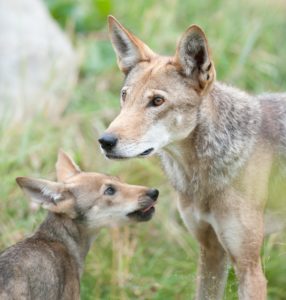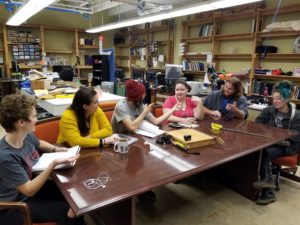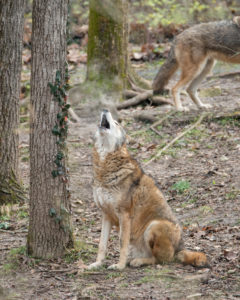We have much more to do and your continued support is needed now more than ever.
Continuing the Conservation Conversation

Red Wolf Recovery in the Past and Present
Conservation of the critically endangered canid, Canis rufus – otherwise known as the red wolf – began almost two decades ago. However, the story of the species has only just started to hit the spotlight. After red wolves were declared extinct in the wild in 1981, The U.S. Fish & Wildlife Service stepped in to save the remaining members of the species. Over the years there have been a number of trials and tribulations for this national treasure. Here are the highlights of the red wolves historical struggle, and the hopes for their success in the future.
A historic challenge
The Red Wolf Recovery Program began when the species was first deemed endangered in 1967. Captive breeding was established shortly thereafter in 1969 at Point Defiance Zoo & Aquarium. Almost a decade later, the first captive bred pups were born, and the struggle for success officially started. The Association of Zoos & Aquariums (AZA) approved the establishment of the Red Wolf Species Survival Plan (SSP) in 1984.

During this time the wild population dwindled, and only 14 true red wolves remained. They were captured and relocated to facilities across the country in order to contribute to the captive breeding program as the last hope for red wolf survival. In 1987, an experimental release of red wolves in the Alligator River National Wildlife Refuge in North Carolina took place, and within the next year the first wild pups were born. By 2006, the wild population had reached an estimated 120+ wolves! However, because of various hunting regulations, as well as other human caused fatalities, the numbers started to decline again.
Arkansas State University (A-State) took on Red Wolves as their new mascot in 2003, generating national attention to the species through A-State athletics. In 2015, a suspension was placed on the reintroduction of red wolves until the recovery program could be reviewed and management techniques could be assessed.
Partnerships for the Pack

About this time, A-State started to get involved with the facilities participating in the Species Survival Plan. A partnership between the Endangered Wolf Center (EWC) in St. Louis and A-State was established. In 2017, A-State announced their commitment to conservation at the annual Species Survival Plan meeting by joining the team, and became the official red wolf repository site for all red wolf samples and specimens. Over the course of the next academic year, students, faculty and staff created an official conservation club, Red Wolves for Red Wolves (RW4RW). The group volunteered at the annual Wolf Fest hosted by the Endangered Wolf Center, where some students were able to see actual red wolves for the very first time.
To raise awareness among students, a common reader The Secret World of Red Wolves, was adopted for all first-year students, as well as a theme of “Mindful Conservation” across all majors. Red Wolves for Red Wolves were able to visit classrooms, attend panels, and conduct other educational outreach events to promote awareness about their beloved mascot.
Chancellor Kelly Damphousse coined the phrase, “Every Red Wolf Counts”, which took the town by storm. The phrase can be found painted on almost every business in town, playing an important role in relaying the conservation message about how critical the population numbers are.
“Every Red Wolf Counts” – Kelly Damphousse, Chancellor, Arkansas State University
2018: The Year of the Red Wolf

2018 has been a big year for red wolves, with 26 pups being born in captivity this spring! (Almost the total number of red wolves in the wild.) With great news such as new pups, conservation centers like New York Wolf Conservation Center have been featured online by People magazine. Other facilities have been making news all across the nation as well. Over the summer, A-State, the Little Rock Zoo, and the Endangered Wolf Center hosted the annual Species Survival Plan (SSP) meeting, where members reviewed educational materials and set goals for education summits, as well as management adjustments for the species. The Association of Zoos and Aquariums went a step further in their commitment to the American red wolf, declaring it a “S.A.F.E” species, as part of their Saving Animals From Extinction collective, which focuses on animals at risk for extinction.
SSP members are more than motivated for this year ahead and have a lot planned for the recovery program. A-State announced future plans to build a red wolf conservation center that would also serve as breeding facility, to help the U.S. Fish and Wildlife Service obtain their goals of nearly doubling the captive population in order to maintain the species survival. Students at the university volunteered at the annual Wolf Fest celebration again this year. Various student organizations have been working with specimens donated to the red wolf repository, allowing them a wonderful opportunity to learn about red wolf ecology. Red Wolves for Red Wolves has continued to make classroom visits to give presentations about red wolves, and will continue to conduct educational outreaches.
Hope for the Future
At this time education is a priority for Species Survival Plan members and red wolf supporters. The goal is to overcome the “big bad wolf” stigma with scientific facts and the heartwarming story of the American red wolf’s resilience over the last few decades, and the perseverance it will take to prevail! By getting the truth about red wolves out there, people will come to love this iconic animal. As Baba Dioum says, “In the end we will conserve only what we love, we will love only what we understand, and we will understand only what we are taught.” Once people understand that “every red wolf counts” they will be more inclined to take action – write letters to their representatives, volunteer with conservation groups, education their friends and family, and participate in other conservation activities. If we all unite, we can save the American red wolf!
Add your voice to the conservation conversation – retweet the following:
As a carnivore native exclusively to the United States, it’s important that we help save this treasured species! Learn more about what @ArkansasState and NWF are doing to help Red Wolves along the recovery process. #SaveRedWolves #EveryRedWolfCounts https://t.co/ChMd8g1M7a pic.twitter.com/Rd23aUy6LG
— National Wildlife Federation (@NWF) November 15, 2018
Elizabeth Etzkorn is the Executive Director of Red Wolves for Red Wolves at Arkansas State University. As a wildlife conservation student at Arkansas State University, her passion for red wolves is second nature. “My efforts to preserve the American red wolf, and other species, are for the sake of my daughter and future generations to enjoy wildlife as much as I do!”





















